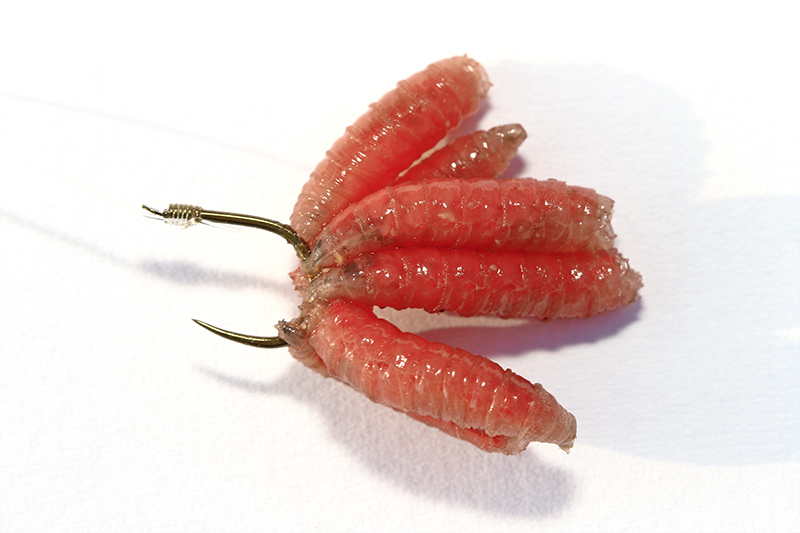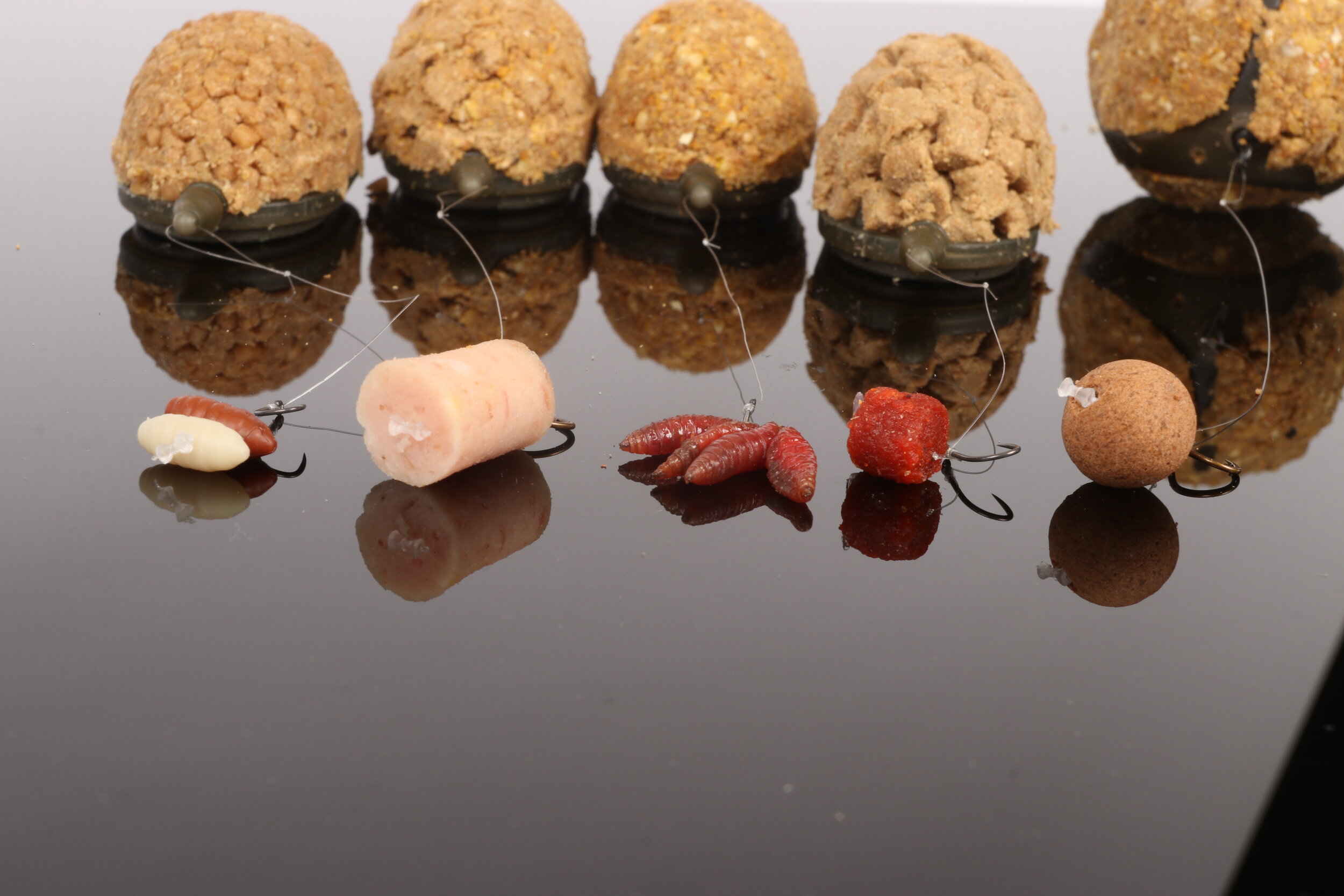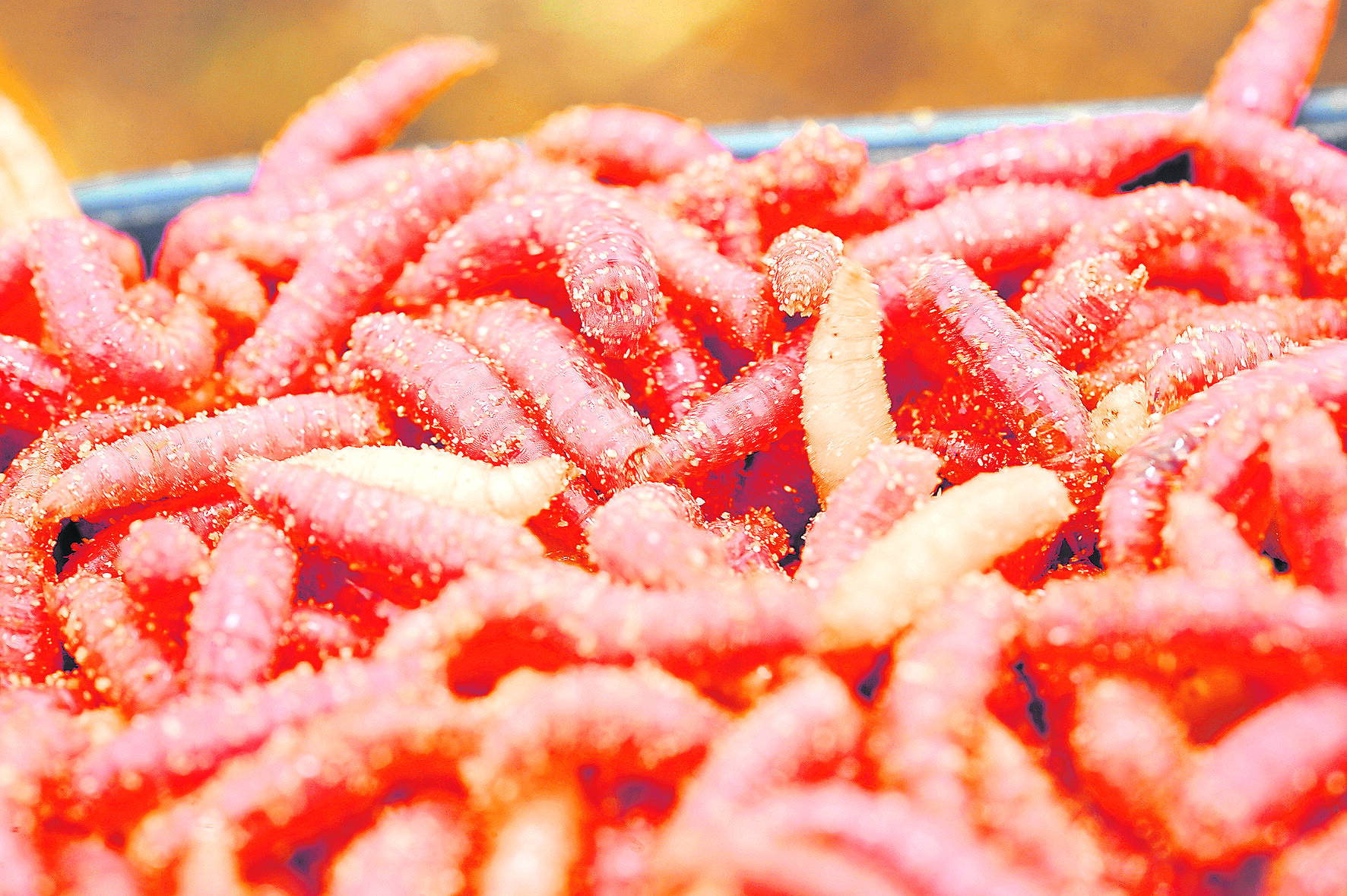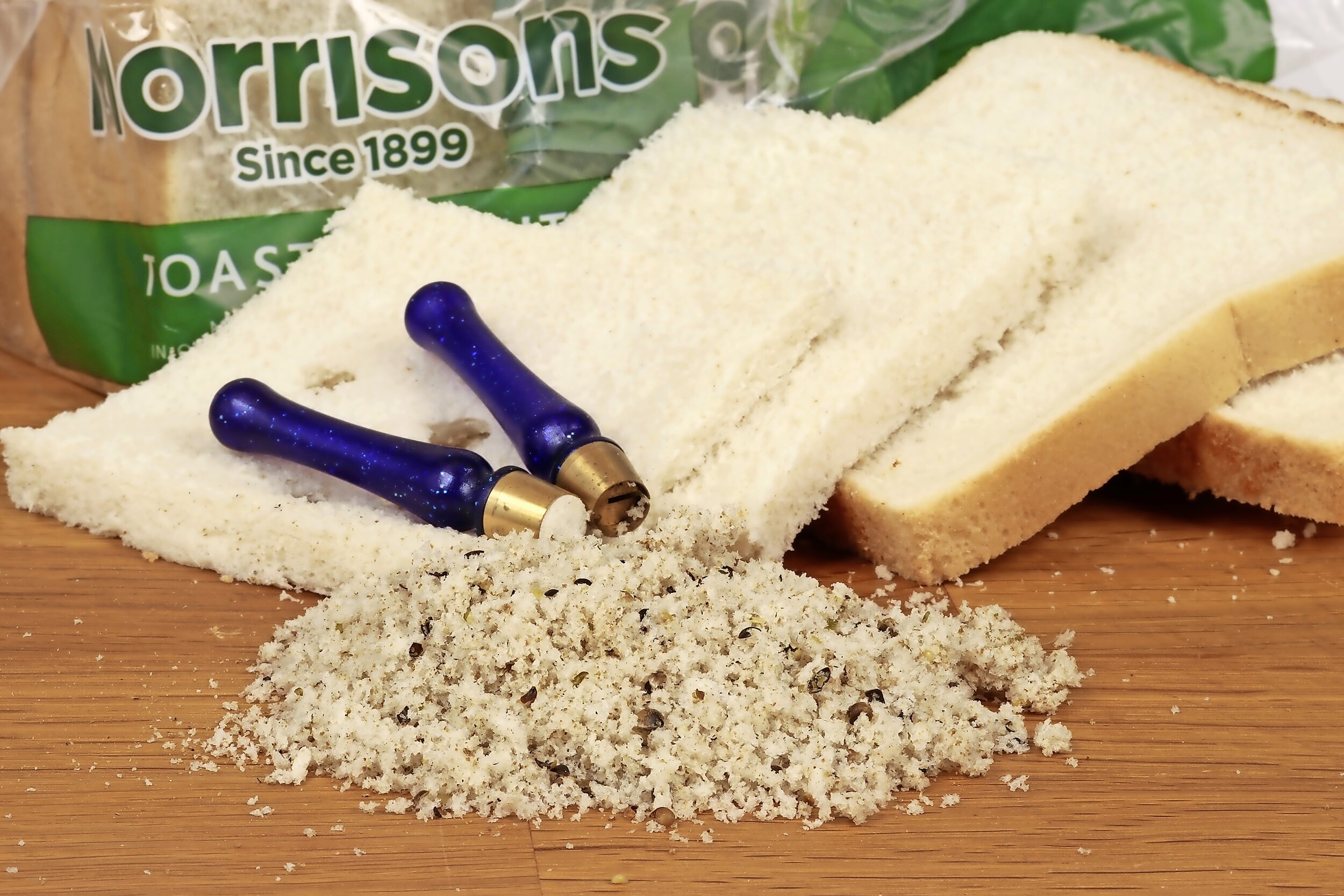Steve Ringer's top 10 baits to use when fishing commercials.
Are you looking for for an edge when it comes to being on a commercial fishery? Then follow match ace Steve Ringer's top 10 baits that he uses when fishing for carp on a commercial as these tips will give you the advantage that you need.
1) Margins – big baits means more bites
When fishing in the edge, one of the hardest things is getting a carp to pick up your hookbait, especially when a lot of them are feeding. I would go as far as to say there is nothing more frustrating than being able to see carp in the edge and then not be able to catch them. This is where a big ‘target bait’ such as 10-12 dead red maggots really comes into its own.
If you think about it there are going to be lots of maggots on the bottom so if I fish just two or three on the hook it’s going to take a while for a carp to find them. Fish a bunch, however, and bites can be instant! That’s how much of a difference it can make.
2) Blow up your pellets
A few years back I was doing a lot of straight lead and pellet fishing but always felt I was missing an edge over other anglers who were fishing the same tactic. Then one day when I was packing up I noticed a few pellets had fallen under my seatbox. What struck me was the size of the pellets – they had taken on water and were almost twice the size.
This got me thinking as the same thing had to be happening in the water once the pellets had been on the bottom a while. I therefore decided to pump some hard 8mm pellets and leave them in water so that they ‘blew up’ into massive, soft pellets.
Once I got the process of prepping the pellets rightthe results were staggering and I was getting more bites than ever before on my ‘new’ blown pellets! I had found the edge I had been looking for and ever since that day when lead and pellet fishing I always have a few ‘blown’ pellets with me.
3) Hard pellets - noise is the key
When the fishing is hard and there isn’t a lot happening I am big believer in trying to draw a few fish into the swim and the best way to do so is to make a noise with hard pellets. I pick up my catapult and ping just 3-4 pellets on top of the float every 20 seconds.
The reason this works is that carp home in on the noise of the pellets hitting the water but at the same time I’m not putting lots of bait on the bottom and risking killing the swim. Size-wise this tactic works best with either 6mm or 8mm pellets because anything smaller doesn’t make enough noise to help pull a fish or two into the swim.
4) Coloured water equals red meat
I love fishing meat but it loses its effectiveness when the water is extremely coloured. When this is the case I will take a handful of my 6mm cubes and dye them red. The reason being when the water is very coloured red offers a strong silhouette and gives the carp a bait they can really home in on.
I was always sceptical about red meat in the past but I’ve had good results using it too many times in coloured water conditions for it to be coincidence. I use Ringers Red Liquid to dye my cubes and will only dye my hookbait meat and not the cubes used for feeding.
5) Foul-hooking? Hemp is the answer
I’m often asked how to prevent foul-hooking carp when fishing meat close in?
My answer is to use hemp. But, and it’s a big but, it has to be used in the right way. If you feed it little and often along with the meat then there is a danger the carp can get preoccupied on it and you won’t be able to catch them.
It’s much better to use hemp purely as settling bait. So at the start I will pot in two thirds of a large 250ml Drennan pot of just hemp to form a bed. Then if I start to catch a few and then start to suffer from foul hooking, I will simply introduce another big pot of hemp to settle them back down again.
6) Feed heavy close in to get out of jail
Every now and again in a match you need a get- out-of-jail card and, while most people use the margins for this, I prefer to fish short on a top kit straight in front of me. I mix hemp, corn and meat and simply lash it in to create the impression of someone packing up and throwing all their bait in.
I normally kick the swim off with three big handfuls of bait and go straight in over the top because quite often I will get a quick response from a fish within seconds. From that point on I will keep lashing the bait.It’s an approach that doesn’t always work but it has paid off on many occasions for it to be my ‘go to’ line when things aren’t going to plan.
7) Pack in the particles for bream
The secret to building a big weight of bream is particles particles – casters, pellets, worms etc. I pile in the particles in the first hour to put a bed of bait on the bottom. To do thisuse a bigger feeder and cast more often. Then when the bream turn up, perhaps 90 minutes in, I have a lot more bait on the bottom to hold the bream for longer.
8) Corn – two grains are better than one
Sweetcorn is a fantastic bait all year round but it’s particularly effective at this time of year. The interesting part about corn is that when it comes to fishing it on the hook then I always tend to find that two grains are without doubt better than one.
Loads of times I have caught on corn and alternated between single and double on the hook only to find two grains constantly produced quicker bites and bigger fish. There are two possible reasons for this, firstly the bigger bait stands out more over the loose offerings so the carp spot it that bit quicker, or it could be that everyone tends to fish a single grain of corn so two grains gets treated with less suspicion.
9) Stand out or blend in?
When fishing the Method or Hybrid feeder there are loads of different hookbaits you can use but I like to simplify things by dividing them into two camps, blend-in and stand-out. Blend-in baits are those such as hard pellets that match the pellets on the feeder. When the fishing is hard this type of bait takes some beating.
The reason for this is that when the fishing is hard there aren’t many fish in the swim so those that are there can afford to be picky about what they pick up. Hence a blend-in bait works well as it can trick even the wariest of carp.
If, however, there are loads of fish in the swim then stand-out baits such as mini fluoro boilies or bread really come into their own. These work because they are highly visible and give the carp something they can really home in on.
10) Give your meat a double cut
A couple of years back I spent a lot of time at Tunnel Barn Farm fishing meat into the shallow water across to far banks and islands. The problem was I struggled to hold the fish in the swim for long periods when feeding 6mm cubes.
What I needed, of course, was to create a cloud to firstly draw the fish in and then hold them in the swim once they arrived. To achieve this I decided to create a meaty mush by passing around a third of my 6mm meat cubes back through the cutter again, giving myself a feed made up of different sizes which almost exploded on the surface of the water.
This was added to 8-10 6mm cubes in my pot so when it was fed the cloudy mush pulled the fish into the swim and once they arrived they followed the 6mm cubes down to the bottom so I could catch them!
Best coarse fishing hookbaits to be using right now!
Tommy Pickering gives his opinion on the best hookbaits that you should be using right now if you are wanting to catch consistently.
The rise in temperatures in recent weeks has stirred fish stocks into feeding, but careful consideration still needs to be given to your bait choices if you are to succeed. Pick the wrong hookbait and there’s every chance that your target species will ignore it and leave you struggling for action. If I had to pick five baits to see me through the next few weeks, these are what they would be...
Casters.
These pick out the biggest silverfish in the shoal – the orangey-brown ones are best. Double and single caster works on a size 16 or 18 hook when roach and skimmers are the target fish.
Pellets.
Fish consider these their main food source. Hard pellets in a bait band score on bomb, waggler or pole for quality carp and F1s. Soft expanders are a better option for bonus tench and skimmers.
Meat.
In winter this can be fantastic on the bomb for commercial carp and F1s or river barbel. I push a tin through a meat cutter to create 6mm or 8mm cubes. Avoid cheap, fatty brands that tend to float.
Maggots.
Maggots tend to attract small fish to start with but bigger bonus fish may then move in. Dead maggots are extremely effective when used as a hookbait on the Method feeder.
Sweetcorn.
In clear water, a grain of corn stands out a mile. Use it on the bomb on a size 16 or 18 hook when casting around to find a shoal, or loosefeed it sparingly on the pole line through a small cup.
Coarse fishing with casters as bait
Casters are the next stage in the life cycle of a maggot. They are the chrysalis of a maggot – a shell-like pupae that contains the soon-to-emerge fly.
Casters are slightly smaller than maggots and their shape is a lot more rounded. They are available at all good tackle shops and, like maggots, are sold by the pint.
Casters are a little bit more expensive than maggots due to the fact that they have taken longer to evolve than maggots, due to the fact that the maggot is stage two of the fly’s life cycle, whereby casters are stage three.
A pint of casters will cost around the £3 mark.
Casters are a superb bait that always tends to pick off the larger fish. Maybe it’s because the casters have a crunchy shell that the larger fish adore, or maybe it’s because the casters aren’t as often fished as maggots – but whatever the case, they certainly do make a great bait.
Turning your own casters
Although casters can be bought from tackle shops, there are times when they aren’t available as they have either sold out, or the bait producer hasn’t managed to run-off enough casters to go around all the shops.
To make a pint of casters you will need just over a pint of maggots – to take into account those that will die. The best maggots to use to create casters are white maggots. Coloured maggots just do not make good casters, probably due to the fact that they contain impurities, in the form of dies, that don’t help the fly’s metamorphosis.
When you get your white maggots home riddle them thoroughly and pick off any dead maggots and maggot skins by hand. You will now be left with a few maggots that have slowed their wriggling down and have started to transform into casters.
These should be tipped into a spare clean bait box and covered with folded sheets of damp newspaper, with the lid placed upon the box. Do not use dripping wet newspaper as the water may gather at the base of the bait box and suffocate some of the casters at the bottom. The best place to store these soon-to-be-casters is in a fridge.
Continue riddling your maggots twice a day, removing the casters and adding any new ones to the supply in your fridge. Within a few days you’ll have more than enough fresh casters to last a session.
Caster colouration and what it means
Buy a bag of casters and you’ll undoubtedly find casters of different shades. The freshest ones will be white or a cream colour, while the oldest will be almost black. Try to buy your casters as fresh as possible as they will not only last longer, they will give the fish a different bait to target – it’s amazing sometimes that a lighter coloured caster will bring about bites much faster than a dark one, and vice versa.
One thing to bear in mind, when you are buying or storing your casters, is the fact that the darker a caster becomes the more buoyant it will be. Light-coloured casters sink very quickly, while those much older, very darkly coloured casters will float.
Dark, floating casters can be used to great effect on occasions, particularly during the summer. Simply leave a helping of casters out in the sun (but beware of birds scoffing them all) and allow the sun to dry them out and turn the shell dark brown. A full day in the sunshine will crisp-up the shells, darken them dramatically and transform them into floaters. They can now be used on the hook to present a really slow-falling bait to catch fish on-the-drop, or they can be catapulted out as feed for surface feeding rudd or carp.
Hooking casters
Most baits are best used with a hook that matches the size of the bait, but casters are best used with a hook that fits inside the bait. A size 20 or 18 hook fits perfectly inside a single large caster, but that’s not to say that casters cannot be side hooked, they can.
The most important point to note when hooking casters is to do it gently and carefully because if the caster bursts it will become almost useless. And remember to use a very sharp hook!
Casters and groundbait
Casters are one of the best baits to add to groundbait. Why? Because they provide a mass of protein-rich food that the fish will happily feed upon once they find the flavoured groundbait crumbs. But another great reason why casters are so good in groundbait is because they don’t wriggle, therefore they won’t break up the groundbait as it flies or when it lands on the lake or river bottom.
Caster myths
A lot of anglers think that adding crushed casters to a groundbait mix will make it a lot more appealing to fish. Although the extra scent of the crushed casters will draw in fish, crushing the casters will do more harm than good.
The shells of crushed casters float and therefore as soon as the ball of groundbait breaks down, or a fish disturbs it, the caster shells will begin to rise. This will attract the fish and they will follow the rising shells, and they will move away from your groundbait.




























